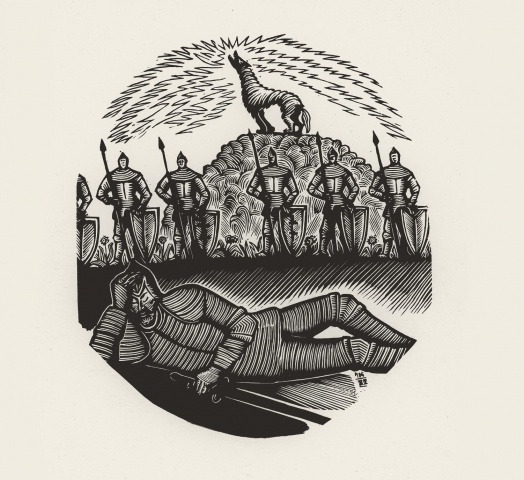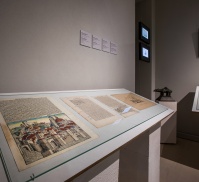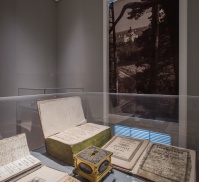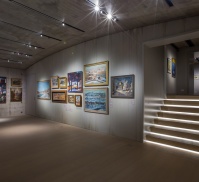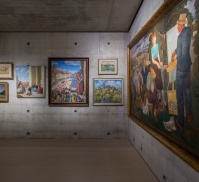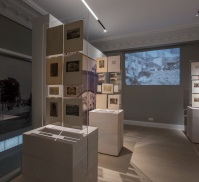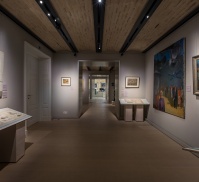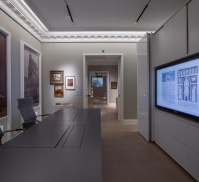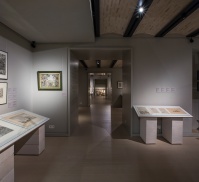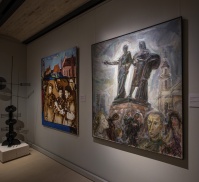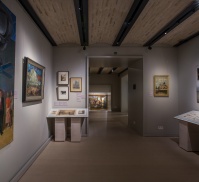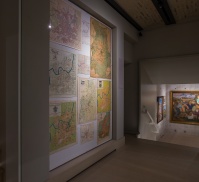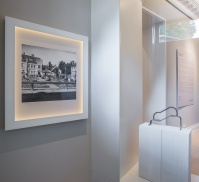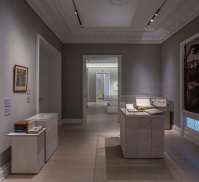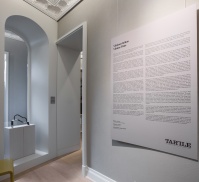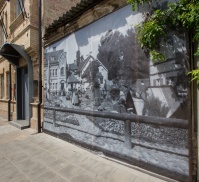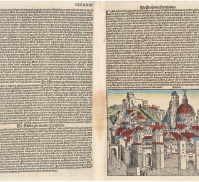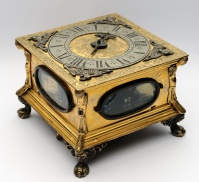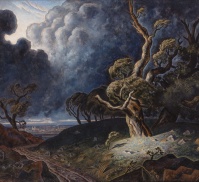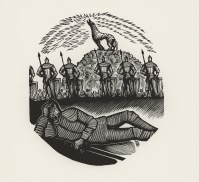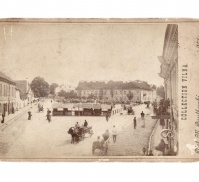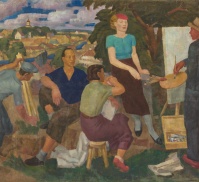Vilnius Time
The sixth exhibition at the Lithuanian Art Centre Tartle is part of an exhibition diptych on the theme of Vilnius, and is one of the 700th anniversary events, inviting visitors to experience the city through different forms of time.
Having amassed the largest private collection of art in Lithuania on the theme of Vilnius, Tartle presents a historically valuable part of its systematically built Vilnius-related collection, showing unexpected glimpses of the history of the capital through works of art and other artefacts that reveal the city’s uniqueness.
Although the exhibition starts by taking us back to the symbolic beginnings of Vilnius, with the legend of its founder and its founding, it then departs from the chronological timeline, and visitors are invited to embark on a journey through the eternal city, whose architectural landscape and nature have attracted photographers and artists with their magical charm since the 19th century.At the same time, through different forms of time, visitors can feel its impermanence and its fragmented history, like a kaleidoscope made up of micro-narratives about the life of residents and the city itself.
The ground-floor room, which resembles a Kunstkammer with its variety of objects, highlights the Lithuanian element of the Tartle collection and its Vilnius-related features, ranging from timepieces with a cultural value, such as a table clock made by the famous local watchmaker and goldsmith Jakob Gierke, or early calendars published in Vilnius, to tourist souvenirs.In the next room, we can admire the aesthetics of frozen time: iconic and timeless views of the city captured by the photographers Józef Czechowicz, the brothers Miron and Leon Butkowski, and Jan Bułhak.
Downstairs we are met by a display of 20th-century cityplans, which reflect changes in the political situation.Leaving behind documented time, visitors will find images of fragmented, real and imaginary Vilnius seen through the eyes of artists from the 15th to the second half of the 20th century.One section is devoted to the subject of leisure, and shows where and how visitors and residents of multi-ethnic and multi-confessional Vilnius liked to amuse themselves.From leisure time, we enter restricted, unconditional and dystopian time, counterbalanced by views of conditional, utopian and imagined Vilnius in the adjacent room: from the first hypothetical images in Renaissance chronicles, to the unrealised projects of the late Soviet era.
The last part of the exhibition does not have a strict narrative, and visitors find themselves in a city that never changes and is familiar to everyone. Through wars, plague, or times of dreams, the seasons repeat themselves year after year, and this never-ending cycle becomes the only certainty.The large hall contains views from the late 19th and 20th century, among which, alongside works by lesser-known artists, visitors will find paintings by Antanas Gudaitis, Bronisław Jamontt, Leonas Katinas, Vincas Kisarauskas, Vytautas Mackevičius, Edvardas Matas Riomeris, Wincenty Sleńdziński, Leopoldas Surgailis, Jonas Švažas and Viktoras Vizgirda.
The exhibition ‘Vilnius Time’ brings together more than 200 exhibits, including paintings, graphic works, sculptural projects, photographs, city plans, small prints, goldsmith’s work, historical documents, and other artefacts from the Tartle collection from the 15th to the 21st centuries.Some of the exhibits were lent by Elona Lubytė and the Museum of the Vilnius Academy of Arts.
In the words of Mikalojus Vorobjovas, a researcher of Vilnius’ history and one of Lithuania’s most distinguished art historians: ‘It is a city with a historical memory that not only lives the superficial life of the present day. It is a city where time is multifaceted and multi-dimensional, because the past here is firmly embedded in the present.’We invite you to see this for yourselves.
Curators Ieva Burbaitė, Emilija Vanagaitė
Architect Vladas Urbanavičius
Graphic designer Daiva Sakalauskienė
Project is financed by Lithuanian Council for Culture
![]()

The sixth exhibition at the Lithuanian Art Centre Tartle is part of an exhibition diptych on the theme of Vilnius, and is one of the 700th anniversary events, inviting visitors to experience the city through different forms of time.
Having amassed the largest private collection of art in Lithuania on the theme of Vilnius, Tartle presents a historically valuable part of its systematically built Vilnius-related collection, showing unexpected glimpses of the history of the capital through works of art and other artefacts that reveal the city’s uniqueness.
Although the exhibition starts by taking us back to the symbolic beginnings of Vilnius, with the legend of its founder and its founding, it then departs from the chronological timeline, and visitors are invited to embark on a journey through the eternal city, whose architectural landscape and nature have attracted photographers and artists with their magical charm since the 19th century.At the same time, through different forms of time, visitors can feel its impermanence and its fragmented history, like a kaleidoscope made up of micro-narratives about the life of residents and the city itself.
The ground-floor room, which resembles a Kunstkammer with its variety of objects, highlights the Lithuanian element of the Tartle collection and its Vilnius-related features, ranging from timepieces with a cultural value, such as a table clock made by the famous local watchmaker and goldsmith Jakob Gierke, or early calendars published in Vilnius, to tourist souvenirs.In the next room, we can admire the aesthetics of frozen time: iconic and timeless views of the city captured by the photographers Józef Czechowicz, the brothers Miron and Leon Butkowski, and Jan Bułhak.
Downstairs we are met by a display of 20th-century cityplans, which reflect changes in the political situation.Leaving behind documented time, visitors will find images of fragmented, real and imaginary Vilnius seen through the eyes of artists from the 15th to the second half of the 20th century.One section is devoted to the subject of leisure, and shows where and how visitors and residents of multi-ethnic and multi-confessional Vilnius liked to amuse themselves.From leisure time, we enter restricted, unconditional and dystopian time, counterbalanced by views of conditional, utopian and imagined Vilnius in the adjacent room: from the first hypothetical images in Renaissance chronicles, to the unrealised projects of the late Soviet era.
The last part of the exhibition does not have a strict narrative, and visitors find themselves in a city that never changes and is familiar to everyone. Through wars, plague, or times of dreams, the seasons repeat themselves year after year, and this never-ending cycle becomes the only certainty.The large hall contains views from the late 19th and 20th century, among which, alongside works by lesser-known artists, visitors will find paintings by Antanas Gudaitis, Bronisław Jamontt, Leonas Katinas, Vincas Kisarauskas, Vytautas Mackevičius, Edvardas Matas Riomeris, Wincenty Sleńdziński, Leopoldas Surgailis, Jonas Švažas and Viktoras Vizgirda.
The exhibition ‘Vilnius Time’ brings together more than 200 exhibits, including paintings, graphic works, sculptural projects, photographs, city plans, small prints, goldsmith’s work, historical documents, and other artefacts from the Tartle collection from the 15th to the 21st centuries.Some of the exhibits were lent by Elona Lubytė and the Museum of the Vilnius Academy of Arts.
In the words of Mikalojus Vorobjovas, a researcher of Vilnius’ history and one of Lithuania’s most distinguished art historians: ‘It is a city with a historical memory that not only lives the superficial life of the present day. It is a city where time is multifaceted and multi-dimensional, because the past here is firmly embedded in the present.’We invite you to see this for yourselves.
Curators Ieva Burbaitė, Emilija Vanagaitė
Architect Vladas Urbanavičius
Graphic designer Daiva Sakalauskienė
Project is financed by Lithuanian Council for Culture
![]()






